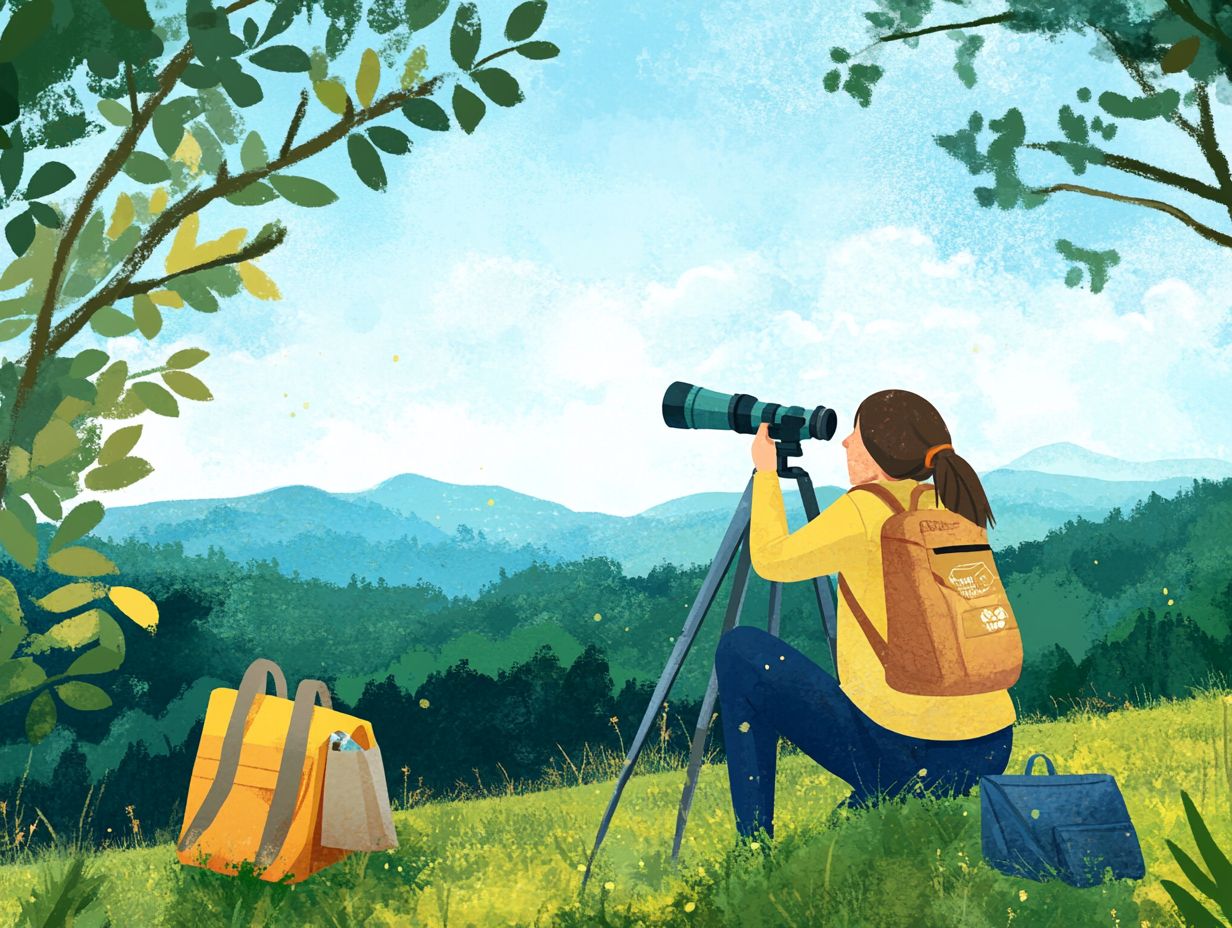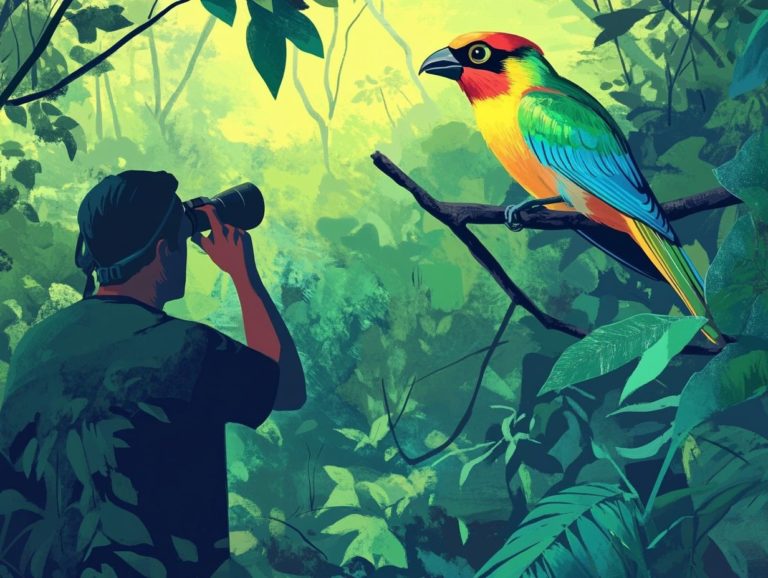How to Use Spotting Scopes for Nature Observation
Spotting scopes are important tools for nature enthusiasts like you, granting the clarity and detail needed to fully appreciate wildlife in their natural habitats.
This article delves into the many benefits of using spotting scopes, from enhanced visibility to their conveniently portable designs. It guides you through selecting the right scope, setting it up for optimal performance, and mastering techniques for spotting wildlife effectively.
Whether you re a seasoned observer or just beginning your journey, you ll discover tips that will elevate your nature-watching experience to new heights!
Contents
- Key Takeaways:
- What is a Spotting Scope?
- Benefits of Using Spotting Scopes for Nature Observation
- Choosing the Right Spotting Scope
- Setting Up Your Spotting Scope
- Techniques for Using Spotting Scopes
- Frequently Asked Questions
- What is a spotting scope and why is it useful for nature observation?
- How do I set up a spotting scope for nature observation?
- Can I use a spotting scope for both day and night observation?
- What features should I look for when purchasing a spotting scope for nature observation?
- How far can a spotting scope zoom in?
- Can I use a spotting scope with my phone for nature photography?
Key Takeaways:

- Spotting scopes provide enhanced visibility and magnification, making them a valuable tool for nature observation.
- Consider factors such as magnification, lens size, and weight when choosing a spotting scope for your specific needs.
- Proper assembly and adjustment of your spotting scope is essential for optimal use and accuracy in spotting wildlife.
What is a Spotting Scope?
A spotting scope is your compact, high-performance ally for viewing distant objects. It’s an essential asset for pursuits like bird watching, wildlife observation, and for discovering top bird watching locations, as well as nature photography.
With impressive magnification capabilities, these scopes empower you to see details that escape the naked eye. Imagine the vibrant plumage of a bird perched high in a tree or the subtle movements of wildlife across expansive landscapes!
Spotting scopes come in a range of designs, from angled to straight configurations. They cater to your preferences, ensuring an optimal viewing experience regardless of outdoor conditions.
The quality of the lenses plays a crucial role in enhancing optical performance, delivering clarity and brightness even in low-light environments.
For instance, an angled scope is often the go-to choice for group viewing, allowing multiple people to comfortably share the experience. Meanwhile, straight scopes offer a more direct line of sight, which some find easier to navigate in specific situations.
Whether you’re a seasoned bird watcher or just starting out, the right spotting scope can truly elevate your outdoor adventures. It enables you to appreciate the intricate beauty of nature in stunning detail. To enhance your experience further, learning how to use a spotting scope with a camera can lead to unforgettable moments as you observe wildlife in their natural habitat.
Benefits of Using Spotting Scopes for Nature Observation
Spotting scopes offer a wealth of advantages for nature observation, especially during activities such as bird watching and wildlife viewing. To enhance your experience, learn how to use a spotting scope for bird identification; the clarity of the images and the quality of optical construction can elevate your experience to new heights.
With these scopes, you can observe distant subjects with astonishing detail and precision. They are essential tools for outdoor enthusiasts, photographers, and hunters alike. Thanks to high magnification and superior lens quality, these optical instruments excel in diverse conditions, including low light.
They also feature ergonomic designs that prioritize your comfort during extended use.
Enhanced Visibility and Magnification
One primary advantage of spotting scopes lies in their remarkable visibility and high magnification capabilities. They allow you to observe wildlife and distant landscapes with unparalleled detail.
Whether you re catching a glimpse of birds at a festival or studying the intricate features of an animal in its natural habitat, the superior optical performance of these devices guarantees exceptional image quality and vivid color contrast.
This enhanced visibility is especially advantageous for tasks requiring precision, such as target shooting or nature photography.
The advanced optical construction, featuring high-quality glass and specialized lens coatings, significantly reduces glare and boosts light transmission. This results in brighter, clearer images, even in low-light conditions.
A larger objective lens size plays a crucial role in gathering more light, further enhancing visibility across varying distances. Features like fully multi-coated lenses contribute to improved color accuracy and sharpness, making your observations more vibrant and lifelike.
These elements come together to elevate the spotting scope experience, appealing to those who seek the best in clarity and detail. So, are you ready to embark on a wildlife adventure or refine your shooting skills with a spotting scope?
Portability and Versatility

Spotting scopes are celebrated for their portability and versatility. They are the perfect companion for outdoor enthusiasts like you who need durable, lightweight equipment for activities such as birdwatching and wildlife observation. To learn more, check out our beginner’s guide to understanding spotting scopes.
With a thoughtful design, these scopes are easily transportable and can be set up in various environments, whether you’re at a shooting range, a birding festival, or wandering along a nature trail. The ability to use a tripod makes it steadier, allowing you to achieve optimal viewing conditions tailored to your preferences.
The lightweight design is engineered for effortless carrying, even on your longest adventures. Robust materials provide the resilience needed to withstand the elements. You ll appreciate features like waterproofing and fog-proof construction, ensuring reliable performance no matter the weather.
Plus, compatibility with a range of tripods adds flexibility, letting you select equipment that suits your unique needs. This seamless blend of convenience and adaptability elevates your overall experience, allowing you to immerse yourself in nature without the weight of cumbersome gear.
Choosing the Right Spotting Scope
Discover the features that will elevate your outdoor adventures! When selecting the right spotting scope, consider several essential factors: scope quality, optical performance (how well the scope lets you see details), and a price range that aligns with your budget. This helps you find the right tool for your wildlife observation or birdwatching.
Evaluate the magnification range and lens quality, as these aspects significantly impact clarity and detail of your viewing experience. With a myriad of options available, grasping these elements will empower you to make an informed decision that reflects your personal preferences and intended usage scenarios.
Factors to Consider
When selecting a spotting scope, you need to consider crucial factors like the magnification range, lens quality, and features such as waterproof and fog-proof construction. These elements significantly enhance your experience in various outdoor conditions.
An ergonomic design is essential for comfort during extended use, allowing you to fully enjoy birdwatching or wildlife observation without straining your body. Examine the optical construction and lens coatings; this will give you insight into the image clarity and color contrast you can expect.
The magnification range is paramount; an ideal scope offers the flexibility to capture both close-up details and distant vistas. High-quality lenses equipped with anti-reflective coatings are vital for minimizing glare and maximizing brightness, ensuring that the images are sharp and rich in detail.
Your experience will be significantly enhanced if the scope features user-friendly controls for easy adjustments on the fly. It s also important to ensure that the scope is rugged and built to withstand the elements, enabling you to confidently explore remote locations. Plus, a lightweight design makes transportation effortless over long distances.
Setting Up Your Spotting Scope
Setting up your spotting scope correctly is vital for achieving optimal viewing results. It involves a few key steps that can significantly enhance both image sharpness and overall performance.
Start by ensuring that your tripod height is tailored to your viewing position; a stable base is essential for maintaining clarity and minimizing vibrations. Familiarize yourself with the adjustments of the optical tube. This knowledge will enable you to align your scope for the best perspective possible whether you’re birdwatching, observing wildlife, or capturing stunning photographs.
Proper Assembly and Adjustment

Proper assembly and adjustment of your spotting scope are crucial for achieving exceptional image quality and enhancing your user experience. The user guide that accompanies your product outlines specific techniques that are essential to follow.
Pay close attention to the assembly process, ensuring each component aligns correctly and that the lens and optical tube are securely attached.
Elevate your viewing experience by learning adjustment techniques to fine-tune clarity and detail as you observe wildlife or engage in nature photography.
Attention to these details not only optimizes the performance of your spotting scope but also extends its lifespan. Secure your tripod mount now, and adjust the height to your comfort for an optimal viewing experience!
Once the scope is positioned, use the focus wheel and diopter adjustments to accommodate your individual eyesight variations. Techniques like parallax adjustment, which helps you see distant objects more clearly, are vital for distant viewing, allowing for sharper images that capture every moment.
Calibrating the reticle accurately ensures precision in measurements, benefiting both enthusiasts and professionals alike. Master these techniques from the user guide to fully immerse yourself in the experience, capturing the intricate beauty of nature with stunning clarity.
Techniques for Using Spotting Scopes
Learn how to maximize the performance of your spotting scope with tips for beginners. Utilizing effective techniques can elevate your wildlife observation and birdwatching experiences to a whole new level.
Embrace tips that enhance optical performance and user satisfaction, so you can truly appreciate the beauty of nature.
Understanding the fundamentals of using your smartphone to take pictures through the spotting scope will expand your photography capabilities, enabling you to capture breathtaking images of wildlife.
As you master these techniques, you ll enrich your overall experience, immersing yourself in the intricate details of the natural world, while ensuring image sharpness.
Tips for Spotting Wildlife
Spotting wildlife demands a discerning eye and specific techniques to boost your chances of successful observation, especially in diverse outdoor conditions. To enhance your experience, consider setting up your spotting scope properly to grasp the optimal field of view and more effectively locate and track moving subjects.
Patience and stealth, combined with the features of your scope, will allow you to savor the intricate details of wildlife in their natural habitats.
Don’t miss out on the best times to see animals get up early and stay out late! The early mornings and late afternoons are often your best bet for observing animals, as they tend to be more active during these cooler periods.
Familiarizing yourself with the local ecosystem and its inhabitants can significantly enhance your success, offering valuable insight into their routines and preferred habitats.
Wearing camouflage clothing will help you blend seamlessly into your surroundings, minimizing disturbances. Ultimately, embracing the quiet moments and remaining still will not only increase your chances of encountering elusive species but also deepen your connection with nature.
Get ready to discover the wonders of nature like never before!
Utilizing Different Features
Ready to elevate your viewing experience? Master your spotting scope’s features with our guide on spotting scope optics and transform your observations into thrilling adventures!
Use the different features of your spotting scope. Zoom eyepieces and various eyepiece options can greatly enhance your viewing experience.
Understanding the advantages of lens coatings and their impact on light transmission will enhance optical performance, especially in low-light conditions.
By learning to adjust the main body of the scope and experimenting with these features, you can customize your scope to suit your wildlife observation or photography needs. This makes it versatile for activities like target shooting or hunting optics.
High-quality lens coatings are crucial for performance. Multi-coated lenses ensure superior light transmission, minimizing glare and enhancing contrast essential when tracking elusive wildlife or capturing breathtaking landscapes.
Mastering the use of zoom eyepieces allows you to swiftly transition between different magnifications. This enables you to adapt to varying distances without sacrificing clarity. By honing these skills, you can unlock the full potential of your spotting scope, making each observation a rewarding experience filled with crisp, vibrant details.
Consider reviewing product recommendations available online or at local birding festivals to help you select the right equipment for your needs.
Frequently Asked Questions
What is a spotting scope and why is it useful for nature observation?
A spotting scope is a small, portable telescope designed specifically for terrestrial use. It is useful for nature observation because it provides high magnification, allowing you to see details of distant objects such as birds, animals, and landscapes. If you’re interested in enhancing your viewing experience, learn how to use a smartphone with your spotting scope.
How do I set up a spotting scope for nature observation?
First, attach the spotting scope to a tripod for stability. Then, adjust the eyepiece and focus knob until the image is sharp and clear. Finally, adjust the magnification to your desired level.
Can I use a spotting scope for both day and night observation?
Yes, some spotting scopes have low-light capabilities, making them suitable for night observation. However, be aware that they may not be as effective as night-specific devices such as binoculars or telescopes.
What features should I look for when purchasing a spotting scope for nature observation?
Some important features to consider include magnification power, lens diameter, field of view, and durability. Look for a spotting scope that is waterproof and fog-proof so you can use it in different weather conditions.
How far can a spotting scope zoom in?
The magnification power of a spotting scope can vary, but most models have a range of 20x to 60x. This allows you to zoom in on objects up to 60 times their original size.
Can I use a spotting scope with my phone for nature photography?
Yes, many spotting scopes come with smartphone adapters that allow you to attach your phone and capture photos or videos of your observations. Just make sure your phone is compatible with the adapter before purchasing.







